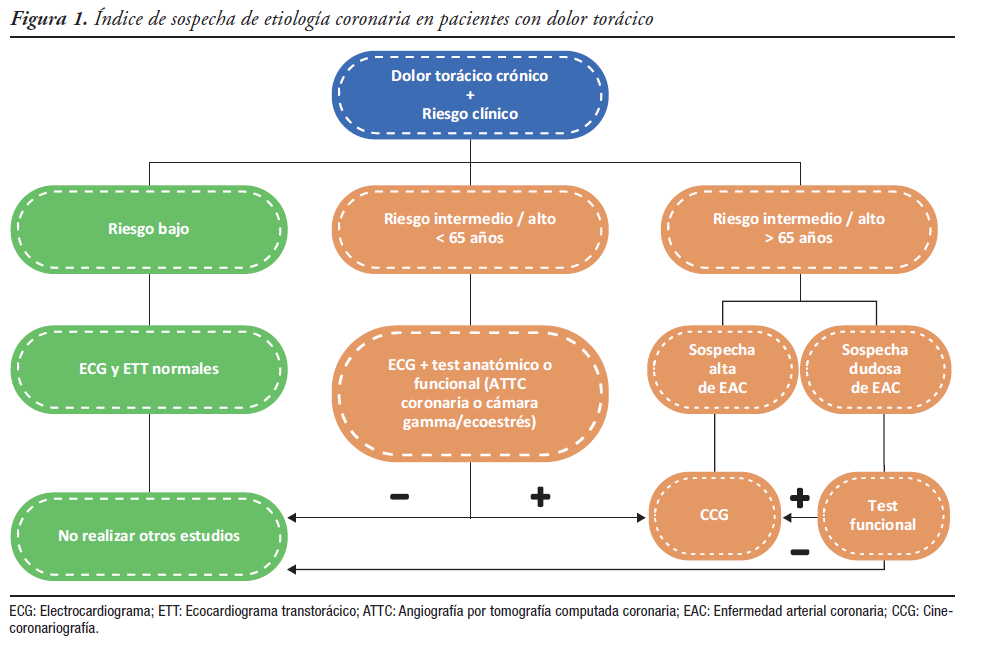Coronary Artery Disease and Chronic Chest Pain: Current Approach According to the Latest Guidelines
DOI:
https://doi.org/10.52787/agl.v52i4.262Keywords:
Chest pain, coronary artery disease, chronic coronary syndromeAbstract
Coronary artery disease usually manifests with typical characteristics, resulting from partial or total occlusion of circulation in the epicardial arteries. However in a specific group of patients, may present with unusual symptoms. For this reason, when evaluating a patient with chest pain, it is essential to carry out an exhaustive anamnesis to detail the characteristics of the clinical presentation as well as a complete evaluation of risk factors and previous cardiovascular history. In this way, it will be possible to evaluate the pre-test and the clinical probability of the patient of developing coronary artery disease. In addition, with the help of complementary studies, an evaluation can be carried out to guide future diagnostic and/or therapeutic behaviors according to the specific case.
References
-1. Knuuti J, Wijns W, Saraste A, et al. 2019 ESC Guidelines for the diagnosis and management of chronic coronary syndromes. Eur Heart J. 202014;41(3):407-77. doi: 10.1093/eurheartj/ehz425
-2. Hsia RY, Hale Z, Tabas JA. A national study of the prevalence of lifethreatening diagnoses in patients with chest pain. JAMA Intern Med. 2016;176:1029-32.
-3. Fanaroff AC, Rymer JA, Goldstein SA, et al. Does this patient with chest pain have acute coronary syndrome?: the rational clinical examination systematicreview. JAMA. 2015;314:1955-65.
-4. Duronto E, Navarro Estrada JL, Benger J, et al. Consenso para el Manejo de Pacientes con Dolor Precordial. Rev Argent Cardiol. 2016;84:378-401. http://dx.doi.org/10.7775/rac.es.v84.i4.9074
-5. Gulati M, Levy PD, Mukherjee D, et al. 2021 AHA/ACC/ASE/CHEST/SAEM/SCCT/SCMR Guideline for the Evaluation and Diagnosis of Chest Pain: A Report of the American College of Cardiology/American Heart Association Joint Committee on Clinical Practice Guidelines. Circulation. 202130;144(22):e368-e454. doi: 10.1161/CIR.0000000000001029. Epub 2021 28 de octubre.
-6. 2019 ESC/EASD Guidelines on diabetes, pre-diabetes, and cardiovascular diseases. Eur Hear J. 2019: en prensa.
-7. Piepoli MF, Hoes AW, Agewall S, et al. 2016 European Guidelines on cardiovascular disease prevention in clinical practice: The Sixth Joint Task Force of the European Society of Cardiology and Other Societies on Cardiovascular Disease Prevention in Clinical Practice (constituted by representatives of 10 societies and by invited experts) Developed with the special contribution of the European Association for Cardiovascular Prevention & Rehabilitation (EACPR). Eur Heart J. 2016;37:2315-2381.
-8. Catapano AL, Graham I, De Backer G, et al. 2016 ESC/EAS Guidelines for the management of dyslipidaemias. Eur Heart J. 2016;37:2999-3058.
-9. Di Angelantonio E, Chowdhury R, Sarwar N, et al. Chronic kidney disease and risk of major cardiovascular disease and nonvascular mortality: prospective population based cohort study. BMJ. 2010;341:c4986.
-10. Daly C, Norrie J, Murdoch DL, Ford I, Dargie HJ, Fox K; TIBET (Total Ischaemic Burden European Trial) study group. The value of routine non-invasive tests to predict clinical outcome in stable angina. Eur Heart J. 2003;24:532-540.
-11. Steeds RP, Garbi M, Cardim N, et al. Scientific Documents Committee. EACVI appropriateness criteria for the use of transthoracic echocardiography in adults: a report of literature and current practice review. Eur Heart J Cardiovasc Imaging. 2017;18:1191-1204.
-12. De Bruyne B, Pijls NH, Kalesan B, et al. FAME 2 Trial Investigators. Fractional flow reserve-guided PCI versus medical therapy in stable coronary disease. N Engl J Med. 2012;367:9911001.
-13. Tonino PA, De Bruyne B, Pijls NH, et al. FAME Study Investigators. Fractional flow reserve versus angiography for guiding percutaneous coronary intervention. N Engl J Med. 2009;360:213-224.
-14. Knuuti J, Ballo H, Juarez-Orozco LE, et al. The performance of non-invasive tests to rule-in and rule-out significant coronary artery stenosis in patients with stable angina: a meta-analysis focused on post-test disease probability. Eur Heart J. 2018;39:3322-3330.
-15. Gueret P, Deux JF, Bonello L, et al. Diagnostic performance of computed tomography coronary angiography (from the prospective national multicenter multivendor EVASCAN study). Am J Cardiol. 2013;111:471-478.
-16. Neumann FJ, Sousa-Uva M, Ahlsson A, et al. 2018 ESC/EACTS Guidelines on myocardial revascularization. Eur Heart J. 2019;40:87165.
-17. Toth G, Hamilos M, Pyxaras S, et al. Evolving concepts of angiogram: fractional flow reserve discordances in 4000 coronary stenoses. Eur Heart J. 2014;35:2831-2838.
-18. Jeremias A, Maehara A, Genereux P, et al. Multicenter core laboratory comparison of the instantaneous wave-free ratio and resting Pd/Pa with fractional flow reserve: the RESOLVE study. J Am Coll Cardiol. 2014;63:1253-1261.

Published
How to Cite
Issue
Section
License
Copyright (c) 2022 Leandro Barbagelata

This work is licensed under a Creative Commons Attribution-NonCommercial-ShareAlike 4.0 International License.












